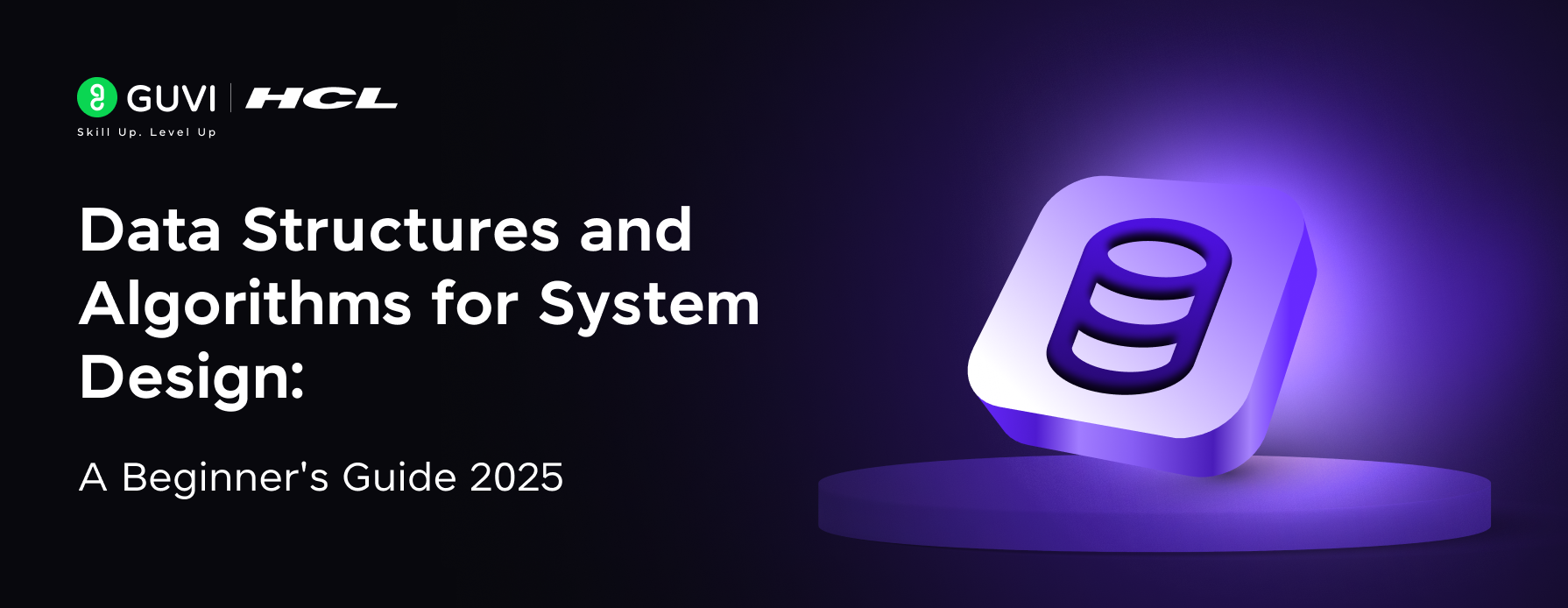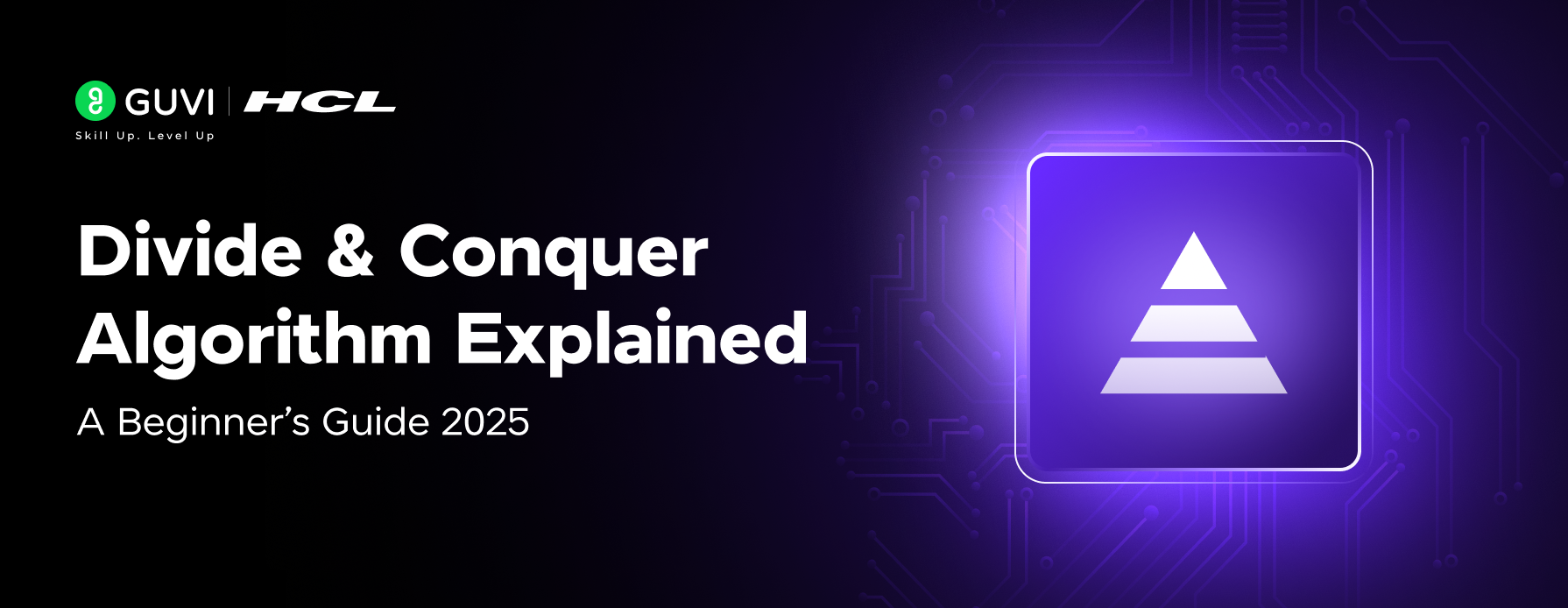
What are Data Structures and Algorithms [DSA]? A Basic Guide
Oct 10, 2025 6 Min Read 5443 Views
(Last Updated)
Tech is always fascinating, and it always gives us a lot of chances to wonder how certain things work. For example, have you ever wondered how applications like Google Maps find the shortest route in seconds or how Amazon shows you the right product with lightning speed?
Behind these intelligent systems lies the foundational backbone of computer science – Data Structures and Algorithms (DSA). As a developer, whether you’re building a simple to-do app or architecting a complex software system, your ability to organize data and solve problems efficiently is crucial. That’s exactly what DSA equips you with.
In this article, we’ll uncover what data structures and algorithms are, why they matter, and how you can start mastering them to become a more effective problem-solver and engineer. So, without further ado, let us get started!
Table of contents
- What are Data Structures?
- Common Data Structures and Their Use Cases
- Choosing the Right Data Structure Matters
- What are Algorithms?
- Key Qualities of a Good Algorithm
- Common Categories of Algorithms
- Real-Life Analogy
- How Do Data Structures and Algorithms Work Together?
- Why They’re a Powerful Pair?
- Getting Started: How to Learn DSA Effectively
- Start with the Fundamentals
- Learn Basic Data Structures First
- Explore Algorithms Side-by-Side
- Progress to Advanced Topics Gradually
- Practice Consistently
- Apply What You Learn
- Stay Consistent and Curious
- Importance of DSA in Computer Science
- Core to Computer Science Theory
- Drives Problem Solving and Logical Thinking
- Boosts Technical Interview Performance
- Improves Real-World Code Quality
- Essential for Advanced Fields
- Conclusion
- FAQs
- What are Data Structures and Algorithms, and why are they important?
- How do Data Structures and Algorithms work together in programming?
- What are some common types of Data Structures and their applications?
- How can one effectively learn Data Structures and Algorithms?
- Why are Data Structures and Algorithms emphasized in technical interviews?
What are Data Structures?
![What are Data Structures and Algorithms [DSA]? A Basic Guide 1 What are Data Structures?](https://www.guvi.in/blog/wp-content/uploads/2025/04/What-are-Data-Structures-1200x630.webp)
To understand Data Structures and Algorithms more effectively, it is best if we split it into two as both are very separate domains combining to form a dynamic duo!
A data structure is a specific way to store and organize data in a computer so that it can be used effectively. Different data structures are tailored for different tasks, some offer fast retrieval, and others are optimized for easy insertion or deletion.
Imagine you’re organizing files:
- A stack is like a pile of trays—you only access the one on top.
- A queue is like a line of people—you serve the first one who arrives.
- A hash table is like a digital address book—you look things up by a key (like a name or phone number).
Common Data Structures and Their Use Cases
| Data Structure | Description | Common Use Cases |
| Array | Fixed-size, indexed collection of elements | Store list of items, fast access by index |
| Linked List | Sequence of nodes where each points to the next | Efficient insert/delete at head/tail |
| Stack | LIFO (Last In, First Out) | Undo functionality, parsing expressions |
| Queue | FIFO (First In, First Out) | Task scheduling, printer queues |
| Hash Table (Map) | Key-value pairs with fast lookup | Caching, databases, symbol tables |
| Tree | Hierarchical data structure | File systems, XML/HTML parsers |
| Graph | Nodes connected by edges | Social networks, route finding |
Choosing the Right Data Structure Matters
Suppose you’re building a music playlist. If you want to:
- Play songs in the order they were added → Queue
- Jump to any song instantly → Array
- Manage favorites and recently played efficiently → Hash Map + Stack
Each choice affects performance and user experience.
If you are wondering why Data Structures and Algorithms are this important and why you should learn it at all costs, here are some reasons to help you start with – 5 Best Reasons to Learn Data Structures and Algorithms [DSA]
What are Algorithms?
![What are Data Structures and Algorithms [DSA]? A Basic Guide 2 What are Algorithms?](https://www.guvi.in/blog/wp-content/uploads/2025/04/What-are-Algorithms-1200x630.webp)
An algorithm is a step-by-step method to perform a task or solve a problem. If data structures are the containers, algorithms are the instructions on how to manipulate the data within them.
Whether you’re sorting a list of names, finding the shortest route on a map, or encrypting a message, you’re using an algorithm.
Key Qualities of a Good Algorithm
- Correctness – It gives the right output for all valid inputs.
- Efficiency – It uses minimum resources (time and space).
- Scalability – It continues to perform well as the input size grows.
- Readability – It’s easy to understand and maintain.
Common Categories of Algorithms
| Algorithm Type | Description | Example Problems |
| Sorting | Arrange items in a specific order | Merge Sort, Quick Sort |
| Searching | Find an element in a collection | Linear Search, Binary Search |
| Recursion | Solve problems by solving smaller instances | Factorial, Fibonacci |
| Dynamic Programming (DP) | Store results of subproblems to avoid recomputation | Longest Subsequence, Knapsack |
| Greedy | Make the best local choice at each step | Activity Selection, Huffman Coding |
| Backtracking | Try all options and backtrack upon failure | Sudoku Solver, N-Queens |
| Graph Algorithms | Traverse or search graphs | BFS, DFS, Dijkstra’s, Kruskal’s |
Real-Life Analogy
Let’s say you’re planning a road trip.
- The map is your data structure (graph).
- Your GPS algorithm finds the shortest path.
- If there’s a roadblock, a backtracking algorithm might re-route you.
- If you want the fastest path based on traffic, you may use a greedy algorithm or dynamic programming.
By understanding both what your data looks like (data structures) and how you process it (algorithms), you’re not just writing code; you’re engineering solutions.
In case you want to pursue Data Structures and Algorithms on a higher level but are confused about where to start, read – Best DSA Roadmap Beginners Should Know
How Do Data Structures and Algorithms Work Together?
![What are Data Structures and Algorithms [DSA]? A Basic Guide 3 How Do Data Structures and Algorithms Work Together?](https://www.guvi.in/blog/wp-content/uploads/2025/04/How-Do-Data-Structures-and-Algorithms-Work-Together-1200x630.webp)
Understanding data structures and algorithms in isolation is useful, but the real power comes when you combine them. In practice, they complement each other to help you solve problems efficiently.
Let’s break it down with a simple analogy:
Think of a data structure as the storage cabinet and the algorithm as the method you use to retrieve or organize the items in it. The cabinet needs to be designed to suit your needs, and your method needs to fit the cabinet’s design.
Why They’re a Powerful Pair?
When you write a program, you’re usually trying to perform operations like inserting, searching, sorting, or updating data. The speed and efficiency of these operations depend on two things:
- How you structure the data (Data Structure)
- How you manipulate that data (Algorithm)
If either one is inefficient, your entire solution suffers.
Data Structures and Algorithms are not just some random tools for development; they are the backbone of real-world systems.
Getting Started: How to Learn DSA Effectively
![What are Data Structures and Algorithms [DSA]? A Basic Guide 4 How to Learn DSA Effectively](https://www.guvi.in/blog/wp-content/uploads/2025/04/Getting-Started_-How-to-Learn-DSA-Effectively-1200x630.webp)
If you’re just starting with Data Structures and Algorithms, it’s easy to feel overwhelmed. There are arrays, linked lists, heaps, graphs… and then sorting, recursion, dynamic programming, and the list goes on. But here’s the good news: You don’t need to master everything at once.
Let’s break down a step-by-step roadmap that helps you learn DSA systematically and effectively.
1. Start with the Fundamentals
Before diving into specific data structures, understand the core concepts:
- Time and Space Complexity (Big O Notation): Learn how to measure the performance of code.
- Basic Operations: Insertion, deletion, traversal, and searching—these operations are common across almost every data structure.
If you’re not clear on how to evaluate performance, even a perfectly written algorithm might be inefficient in practice.
2. Learn Basic Data Structures First
Begin with the most foundational ones:
- Arrays and Strings – Practice manipulating and traversing these. They’re involved in nearly every coding problem.
- Linked Lists – Understand how nodes connect and how memory is used.
- Stacks and Queues – Focus on their LIFO and FIFO behavior and real-world applications (e.g., browser history, task scheduling).
Make sure you know how to implement them both with built-in language features and from scratch.
3. Explore Algorithms Side-by-Side
Once you’re familiar with basic data structures, start learning algorithms in context:
- Searching Algorithms: Linear Search, Binary Search
- Sorting Algorithms: Bubble, Selection, Insertion, Merge, Quick
- Recursive Thinking: Solves problems by breaking them into smaller versions
This is where you begin seeing patterns—something that’s crucial for solving interview questions and real-world problems.
4. Progress to Advanced Topics Gradually
After gaining confidence with the basics, move on to:
- Hash Tables: For constant-time data retrieval
- Trees and Binary Search Trees (BSTs)
- Heaps and Priority Queues
- Graphs: Learn DFS, BFS, Dijkstra’s, Topological Sorting
- Dynamic Programming: Master it by solving subproblem-based questions
- Backtracking and Greedy Algorithms
Tackle these topics one by one, and don’t rush. They require practice and patience.
5. Practice Consistently
DSA isn’t something you just read; you build muscle memory by solving problems.
- Use platforms like LeetCode, HackerRank, CodeKata, and GeeksforGeeks
- Start with easy problems, then move to medium, and eventually hard
- Don’t just aim to “solve” the problem; understand why your approach works and how it can be optimized
6. Apply What You Learn
- Try building DSA mini-projects or solving real-world problems with DSA (e.g., implementing a custom autocomplete, designing a basic file system structure, simulating a game leaderboard).
- Explain solutions to others or write blogs. Teaching reinforces your understanding.
- Participate in coding contests, they train you to solve problems under time pressure.
7. Stay Consistent and Curious
Don’t worry if you don’t get it all on the first go. DSA is about progress, not perfection.
- Dedicate 1–2 hours daily or a few solid sessions weekly
- Revise concepts periodically
- Keep solving problems outside your comfort zone
Remember: mastering DSA is a long-term investment that pays off across your entire tech career.
Importance of DSA in Computer Science
You might ask, “If I can just use libraries and frameworks, why should I invest time learning DSA?”
That’s a fair question. But here’s the truth: DSA is to computer science what grammar is to language; without it, your foundations are weak, and your growth is limited.
Let’s break down its importance from various perspectives:
1. Core to Computer Science Theory
Computer science isn’t just about writing code, it’s about solving problems. DSA provides the mathematical and logical framework to approach problems optimally.
From compiler design to AI, from operating systems to databases, DSA is everywhere. Whether it’s how memory is allocated or how routing happens in networks, it all comes down to the right data structure and the right algorithm.
2. Drives Problem Solving and Logical Thinking
Learning DSA teaches you how to think like a computer:
- Break large problems into smaller parts
- Identify patterns
- Choose the most efficient path to the solution
This kind of structured thinking helps in software development, debugging, and even design decisions.
3. Boosts Technical Interview Performance
Ask any developer who’s landed a job at a top tech company; DSA played a major role.
Most companies use DSA-based coding questions to evaluate:
- Your logical reasoning
- Your ability to write clean, efficient code
- Your understanding of space-time trade-offs
Strong DSA skills increase your confidence and performance in interviews dramatically.
4. Improves Real-World Code Quality
DSA teaches you to write code that’s:
- Scalable: Can handle large inputs and user bases
- Efficient: Fast and memory-friendly
- Reliable: Handles edge cases, recursion limits, and timeouts
Even in high-level frameworks and libraries, understanding what’s happening under the hood gives you a significant advantage.
5. Essential for Advanced Fields
Planning to move into any of the following?
- Machine Learning
- Data Engineering
- Blockchain
- Game Development
- Cybersecurity
- Systems Programming
Every one of these domains relies on complex data structures (like graphs, trees, heaps) and advanced algorithms (like optimization, traversal, or hashing).
A strong grip on DSA ensures you don’t just use tools blindly but understand and innovate within them.
So, after reading all this, if you are ready to start your journey in learning Data Structures and Algorithms, consider enrolling in HCL GUVI’s Data Structures and Algorithms Course with Python – IIT-M Pravartak Certified that includes four in-depth courses across Python, Java, C, and JavaScript. It also helps you to master algorithmic problem-solving and prepare for technical interviews with industry-grade certification!
Conclusion
In conclusion, Data Structures and Algorithms aren’t just academic concepts; they’re practical tools that enable you to build better software, make smarter decisions, and stand out in the tech industry.
By learning how to structure data effectively and apply logical steps to process it, you’re not only improving as a programmer, but you’re also learning how to think computationally and build solutions that truly make an impact.
So, take that first step, keep practicing, and let DSA be the compass that guides your growth in computer science.
FAQs
1. What are Data Structures and Algorithms, and why are they important?
Data Structures are organized ways to store and manage data, such as arrays, linked lists, stacks, and queues. Algorithms are step-by-step procedures or formulas for solving problems. Together, they enable efficient data processing and problem-solving, forming the backbone of software development and computer programming.
2. How do Data Structures and Algorithms work together in programming?
Data Structures provide the means to store data, while Algorithms define the methods to manipulate this data. For example, using a sorting algorithm on an array data structure organizes the data in a specific order.
3. What are some common types of Data Structures and their applications?
Common data structures include Arrays, that is used for storing collections of elements; Linked Lists, which is useful for dynamic memory allocation; Stacks, which follow the Last In First Out (LIFO) principle; Queues, which follow the First In First Out (FIFO) principle; Trees, that are used in databases and file systems; Graphs are used in social networks and transportation systems
4. How can one effectively learn Data Structures and Algorithms?
Begin with understanding basic data structures like arrays and linked lists, then progress to more complex ones like trees and graphs. Practice implementing these structures and associated algorithms in a programming language of your choice. Utilize resources like online courses, coding platforms, and textbooks.
5. Why are Data Structures and Algorithms emphasized in technical interviews?
Proficiency in DSA demonstrates a candidate’s problem-solving abilities and understanding of efficient coding practices. Many technical interviews focus on DSA to assess how candidates approach complex problems, optimize solutions, and utilize fundamental programming concepts.

























Did you enjoy this article?